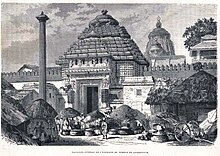The temple was rebuilt by the Ganga dynasty king Anantavarman Chodaganga in the 10th century CE, as suggested by the Kendupatna copper-plate inscription of his descendant Narasimhadeva II.[11] Anantavarman was originally a Shaivite, and became a Vaishnavite sometime after he conquered the Utkala region (in which the temple is located) in 1112 CE. A 1134–1135 CE inscription records his donation to the temple. Therefore, the temple construction must have started sometime after 1112 CE.[12]

Drawing of Puri Temple from the book L'Inde des rajahs : voyage dans l'Inde centrale et dans les présidences de Bombay et de Bengale, 1877
According to a story in the temple chronicles, it was founded by Anangabhima-deva II: different chronicles variously mention the year of construction as 1196, 1197, 1205, 1216, or 1226.[13] This suggests that the temple's construction was completed or that the temple was renovated during the reign of Anantavarman's son Anangabhima.[14] The temple complex was further developed during the reigns of the subsequent kings, including those of the Ganga dynasty and the Gajapati dynasty.[15]